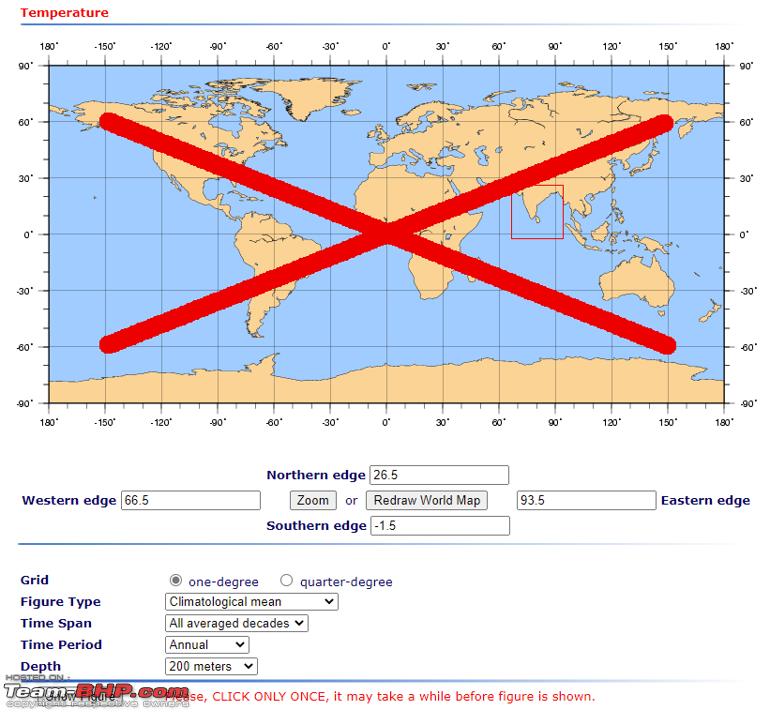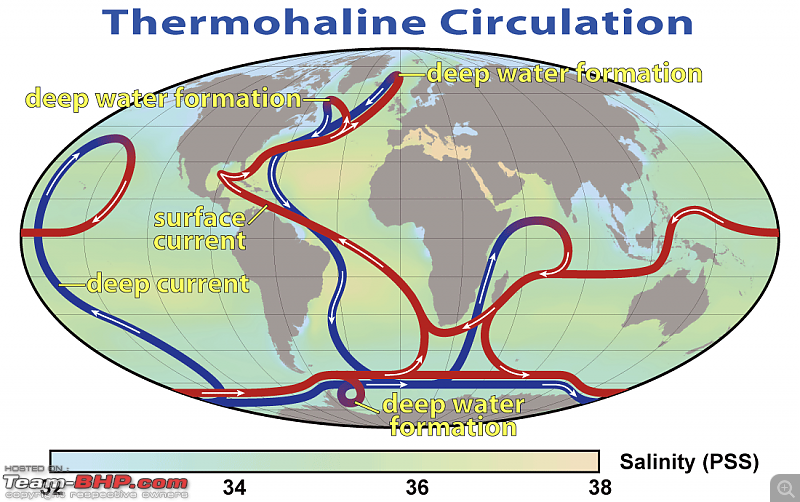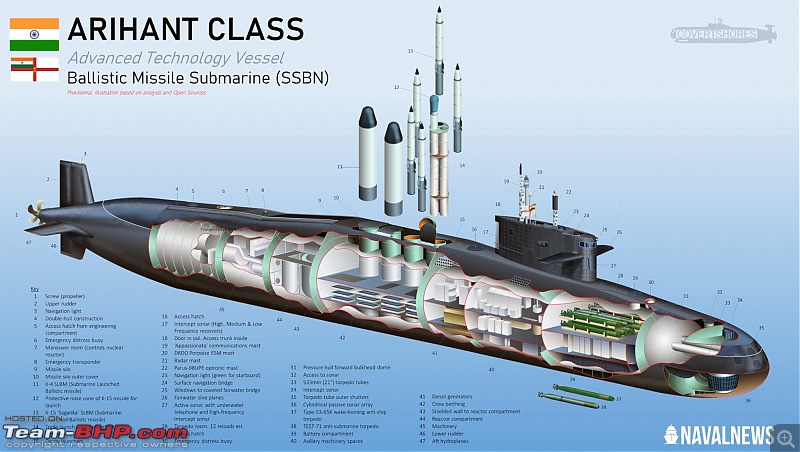| |||||||
| Search Forums |
| Advanced Search |
| Go to Page... |
 |
| Search this Thread |  247,096 views |
| | #211 | |
| BHPian Join Date: Aug 2017 Location: Leeds
Posts: 937
Thanked: 2,259 Times
| Re: Submarines of the Indian Navy Quote:
I think it's going to be unlikely that you'll have very much out in the open domain if any about what exactly the protocol is in terms of rules of engagement in the subsea domain. Secrecy is paramount to either side. Remember, in your scenario say the USN have successfully detected the Russian boat, they won't want to give away to the Russians that they've done so. Similarly the Russians might want to give away the fact that they might be aware of being tailed. Come back to say an air to air intercept between a Russian Bear bomber and an F-15 on patrol, and both sides will be awfully keen to make the other aware of their presence. With submariners it's like playing tag in a large empty hall with blindfolds on. It's only years later do we hear the stories from former submariners about successful tailing operations and close calls and what not. Good luck getting your average Admiral to declassify any of those reports. | |
| |  (5)
Thanks (5)
Thanks
 |
| The following 5 BHPians Thank ads11 for this useful post: | dragracer567, Jeroen, locusjag, skanchan95, V.Narayan |
| |
| | #212 | |
| Distinguished - BHPian  Join Date: Aug 2014 Location: Delhi-NCR
Posts: 4,071
Thanked: 64,335 Times
| Re: Submarines of the Indian Navy Quote:
The first time the Americans acknowledged that a diesel electric boat had got the better of their carriers was versus a Dutch Navy Zwaardvis class boat in the 1980s. It is alleged something similar happened with a Kilo class boat while exercising with the Indian Navy in recent years. This means these boats {Kilo, Zwaardvis, Gotland} got through the multi-layer protective screens surrounding the carrier to get into a firing fix! | |
| |  (7)
Thanks (7)
Thanks
 |
| The following 7 BHPians Thank V.Narayan for this useful post: | ads11, dragracer567, Jeroen, museycal, Rahul Bhalgat, skanchan95, sridhar-v |
| | #213 | |
| BHPian Join Date: Aug 2017 Location: Leeds
Posts: 937
Thanked: 2,259 Times
| Re: Submarines of the Indian Navy Quote:
Summary publications for each data type from the most recent 2018 tranche: https://www.ncei.noaa.gov/access/wor...an-atlas-2018/ WOA home:https://www.ncei.noaa.gov/products/world-ocean-atlas The way NOAA presents this data is as follows:
 This is how it should look. Essentially you define the box within which you want to generate your map/figure, after selecting the property you want. I've selected temperature in this case and then you can toggle between settings for the size of the grid square - think of it as the resolution of the source dataset and the time scales for the averaging. Finally you select the depth you want and it crunches the numbers (this takes time depending on the size of your search area) to present to you the requested map If anyone wanted to do some simple reading the three things to look out for are as follows: Thermocline - this concerns the temperature profile Halocline - this concerns the salinity profile Pycnocline - this concerns the density profile https://en.wikipedia.org/wiki/Cline_(hydrology) Start getting your head around these and you're on the first steps to becoming a ASW specialist. The next part is when you actually understand the physics.. | |
| |  (4)
Thanks (4)
Thanks
 |
| The following 4 BHPians Thank ads11 for this useful post: | dragracer567, museycal, Rahul Bhalgat, V.Narayan |
| | #214 | |
| BHPian Join Date: Aug 2019 Location: Bahrain
Posts: 935
Thanked: 4,984 Times
| Re: Submarines of the Indian Navy Thank you all for what has been quite an interesting read. As an amateur enthusiast, it was a delight reading about the basics of ASW and the various submarine doctrines. Please bear with me on what might a very basic question. While we have discussed ASW by helicopters which use the dipping sonar to get around the limitation brought about by thermocline, where do the fixed-wing aircraft-based ASWs come in? I roughly understand how the MAD in P3s and Indian version of the P8s work but what other ASW sensors do these aircraft carry (eg the American P8s)? Do fixed-wing aircraft function in a complementary manner to ASW helicopter platforms or are they independently formidable ASWs platforms? Quote:
 Last edited by dragracer567 : 11th May 2021 at 00:19. | |
| |  (3)
Thanks (3)
Thanks
 |
| The following 3 BHPians Thank dragracer567 for this useful post: | ads11, Rahul Bhalgat, V.Narayan |
| | #215 |
| BHPian Join Date: May 2013 Location: Mumbai
Posts: 175
Thanked: 595 Times
| Re: Submarines of the Indian Navy Sonar Operations are highly classified by the world's navies and very rightly so. All we can do is just speculate at their techniques and tactics. Please go through these links to help understand the complex world of Sonar better. https://www.thedrive.com/the-war-zon...ctics-and-tech |
| |  (3)
Thanks (3)
Thanks
 |
| The following 3 BHPians Thank DrPriyankT for this useful post: | dragracer567, Rahul Bhalgat, V.Narayan |
| | #216 |
| Distinguished - BHPian  | Re: Submarines of the Indian Navy Sonar secrets brought to you by the Internet. Wait, there is no Wikipedia page on sonar secrets? Bummer!  |
| |  (2)
Thanks (2)
Thanks
 |
| The following 2 BHPians Thank Jeroen for this useful post: | dragracer567, DrPriyankT |
| | #217 |
| Senior - BHPian Join Date: Apr 2011 Location: Pune
Posts: 1,155
Thanked: 1,956 Times
| Re: Submarines of the Indian Navy Dear Sirs V. Narayan and ads11, Thank you so much for sparing a lot of your precious time and for taking so much effort to write and to draw, to make us understand why exactly the submarines will continue to be important in future. I could realise that:
Thank you once again. Last edited by Rahul Bhalgat : 11th May 2021 at 01:46. |
| |  (2)
Thanks (2)
Thanks
 |
| The following 2 BHPians Thank Rahul Bhalgat for this useful post: | dragracer567, V.Narayan |
| | #218 | |
| Distinguished - BHPian  Join Date: Jan 2015 Location: Chennai
Posts: 1,824
Thanked: 8,478 Times
| Re: Submarines of the Indian Navy Quote:
I know that every submarine force has a repository of acoustic signatures on file, including those of natural background noises and that of marine life. On Sunday I was watching a documentary series by Russia Today on Russia's Baltic submarine fleet titled "Combat approved". An officer explained that he can tell if there's a Los Angeles class sub, a commercial trawler, oil tanker, shrimp (knocking sounds), whales or dolphins (staccato clicks) in the vicinity. Here's a rather poor joke, but I remember watching a slapstick comedy movie when I was a kid on Star Movies; two enemy subs are on complete silence, prepared to fire torpedos at each other. No one so much as walks about on either sub, to prevent giving away tell-tale sounds. A fat submariner on the American sub suddenly breaks wind noisily and the American Captain's heart skips a beat; but the Soviets pick up the noise and say "It's just a whale, false alarm" and move away from the vicinity  don't judge me on it but I literally rolled on the floor laughing when I watched this scene ~20 years ago. don't judge me on it but I literally rolled on the floor laughing when I watched this scene ~20 years ago. | |
| |  (5)
Thanks (5)
Thanks
 |
| The following 5 BHPians Thank locusjag for this useful post: | dragracer567, Jeroen, museycal, Rahul Bhalgat, V.Narayan |
| | #219 | ||||
| Distinguished - BHPian  Join Date: Aug 2014 Location: Delhi-NCR
Posts: 4,071
Thanked: 64,335 Times
| Re: Submarines of the Indian Navy Quote:
Quote:
Quote:
It would be too expensive to build any submarine with a limited design depth for presumably coastal operations. The cost of the steel is a fraction of the cost of a submarine. For coastal operations you may, may need, in some cases only a shorter submarine. But modern subs are already quite short and hence manageable in shallow and confined waters. A typical modern diesel electric long range boat is 65 to 70 metres in length compared to 90 to 100 metres a generation ago. And the longer range of both torpedoes and sea skimming missiles means a sub can stand off in slightly deeper and less confined waters today. So the approach is to build a standard submarine that is short enough for coastal work (or littoral as the Americans call it now) and yet has the displacement and internal volume for long range open ocean operations and to perform all the tasks required of it - anti-submarine, anti-surface vessel, inserting commandos, surveillance and in larger boats land attack. And always but always go for maximum depth that you can design. Or you may discover that you need a sub of type A on the West coast on the very day all type A's are on the East Coast for an exercise! The more multi-purpose a submarine or tank or combat aircraft is the more useful it is. In war you don't know what will happen and you don't want your weapons to be specialized to a point that they cannot be used for the task at hand. That only works in video games. Which is why there are only two types of submarines in the main - the boomers and the hunter-killers. The latter, as we know, can be either nuclear powered (SSN) or diesel-electric (SSK). Quote:
Real war is not like a video war game where things are (I'm told) boxed in relative to real life. In real war never underestimate the wisdom, competence and shrewdness of the man behind the gun. I'll share a short anecdote from 1971. One of our Foxtrot class boats which was patrolling, on her batteries, off the Makaran coast, on the Western half I presume, needed to surface to snorkel depth to recharge her batteries. She could also hear in the distance the sounds of a steam turbine driven submarine patrolling somewhere in the vicinity. Probably an American SSN keeping an eye on what we were up to. We experienced the same in the Bay of Bengal too. Clearly the IN sub did not want to be tracked by a, presumably, American boat while charging batteries. So this commander slowly sailed his boat westward towards the crowded Gulf of Oman full of tanker traffic, found a safe spot and fired his diesels for the few hours he needed camouflaged by the enormous amount of ship noise in a busy traffic area. And then got back to where he needed to be. The nuclear powered boat had by then moved on. This was narrated to me by the commander himself decades after 1971. Sadly he is no more. From your questions I get the impression (maybe unfairly) that you are viewing war and tactics as a set piece game where things are in neat clearly defined boxes. Nothing can be further from the truth. Hope this helps. Last edited by V.Narayan : 11th May 2021 at 18:39. | ||||
| |  (7)
Thanks (7)
Thanks
 |
| The following 7 BHPians Thank V.Narayan for this useful post: | ads11, dragracer567, DrPriyankT, Foxbat, locusjag, naveenvenkatesh, Rahul Bhalgat |
| | #220 | |||||
| BHPian Join Date: Aug 2017 Location: Leeds
Posts: 937
Thanked: 2,259 Times
| Re: Submarines of the Indian Navy Quote:
Quote:
Attachment 2154560 If you look at this diagram you can start to see how you're going to have, say in the Arctic circle, near the GIUK gap, very cold Arctic Bottom Water currents moving southward. Similarly in the North Atlantic along the Eastern seaboard you have the interplay between colder Arctic bottom waters moving southward and in the upper part of the water column, the warmer currents at surface level moving northwards. Factor in more localised stronger currents like the boundary currents and you start to have a great deal of temporal variability in your ocean systems - now you can just imagine how that plays with both the sonarmen on the boats themselves and the ASW guys tasked to hunt them. Quote:
Quote:
Quote:
I'm not as well versed with torpedo designs but I would expect that their designs focus primarily to deal with pressure extremities. You have torpedoes with active guidance that are linked by a connecting cable to the boat that launched it. There the torpedo wouldn't really have to think about all the water column variability as the controller is doing that to guide it to target. I suppose those torpedoes that are fire and forget so to speak are the ones where there will be some element of accounting for the variability in the water column as it moves in on target. I can't remember where exactly I read this but there's actually (predictably) some level of gentle hazing or shall we say initiation for new recruits to the submarine service. Now the article I read was concerning the USN but it seems there's distinct communities within a boat itself and the lowest of the low are the new guys. And much like your story one of the common causes for reprimand is whenever a new guy drops something onboard, thus making a loud racket. You can imagine the creative punishment the other men onboard come up for such an infraction, which joking aside does make for a concern due to the manner in which sound easily propagates underwater. | |||||
| |  (4)
Thanks (4)
Thanks
 |
| The following 4 BHPians Thank ads11 for this useful post: | dragracer567, locusjag, Rahul Bhalgat, V.Narayan |
| | #221 | |
| Distinguished - BHPian  Join Date: Jan 2015 Location: Chennai
Posts: 1,824
Thanked: 8,478 Times
| Re: Submarines of the Indian Navy Quote:
The writer ultimately went on to learn how to command the boat in night shifts (or whatever you call them, when the red lights come on within the Con) and if I remember right, he wasn't in command when the boat rammed the undersea hill. | |
| |  (3)
Thanks (3)
Thanks
 |
| The following 3 BHPians Thank locusjag for this useful post: | dragracer567, Rahul Bhalgat, V.Narayan |
| |
| | #222 | |||
| BHPian Join Date: Aug 2017 Location: Leeds
Posts: 937
Thanked: 2,259 Times
| Re: Submarines of the Indian Navy Quote:
https://www.thedrive.com/the-war-zon...-in-the-movies Hopefully in addition to V.Narayan's comments on torpedoes, the above article should cover most of your questions Rahul. Quote:
https://www.thedrive.com/the-war-zon...lear-submarine Excerpts below covering the three main sub groups Quote:
https://www.thedrive.com/the-war-zon...-cant-even-see I won't replicate what's been said here because it's best left described by the actual submariner. I have no doubt that the contents of the article hold true for the profession as a whole, regardless of nationality. Edit: Noticed the image of the ocean conveyor belt system didn't properly attach in my previous post (#220). Hopefully it works this time.  Last edited by ads11 : 11th May 2021 at 22:09. Reason: Adding image that failed to attach properly in previous post | |||
| |  (4)
Thanks (4)
Thanks
 |
| The following 4 BHPians Thank ads11 for this useful post: | dragracer567, locusjag, Rahul Bhalgat, V.Narayan |
| | #223 | |
| Senior - BHPian Join Date: Apr 2011 Location: Pune
Posts: 1,155
Thanked: 1,956 Times
| Re: Submarines of the Indian Navy Quote:
I am just trying to understand the things, out of curiosity. My queries and doubts are those of a common man (I am not even a student, in this field. So no need to assess me). I am glad and thankful to you for your explanation and I presented my interpretation of the same so that it can be corrected or refined as needed, for which I thank you again. I wrote about boat and torpedo variety because I thought that, like industry, versatile machine is not always the best solution in every situation. Thanks for your views on this. | |
| |  (3)
Thanks (3)
Thanks
 |
| The following 3 BHPians Thank Rahul Bhalgat for this useful post: | dragracer567, Kool_Kid, V.Narayan |
| | #224 | |
| Distinguished - BHPian  Join Date: Aug 2014 Location: Delhi-NCR
Posts: 4,071
Thanked: 64,335 Times
| Re: Submarines of the Indian Navy Quote:
| |
| |  (2)
Thanks (2)
Thanks
 |
| The following 2 BHPians Thank V.Narayan for this useful post: | ads11, Rahul Bhalgat |
| | #225 | ||
| BHPian Join Date: Aug 2017 Location: Leeds
Posts: 937
Thanked: 2,259 Times
| Re: Submarines of the Indian Navy Some good discussions on this thread here lately. Seems a timely moment to share a new piece about the Arihant. Granted there's not much here that hasn't been said already and it's clear that there isn't much out there in the public domain (Sutton admits as much) but who doesn't love a good cut away diagram!  Before anyone gets irked I'm spilling state secrets, note that the schematic too cautions this is simply an artists impression. Excerpts below of the bits that caught my eye (emphasis mine): Quote:
Another interesting point is the double hull construction of the Arihant, a Russian trend that the Russians themselves seem to have abandoned for their latest Yasen class SSGN Quote:
Last edited by ads11 : 12th May 2021 at 16:24. | ||
| |  (2)
Thanks (2)
Thanks
 |
| The following 2 BHPians Thank ads11 for this useful post: | Rahul Bhalgat, V.Narayan |
 |


